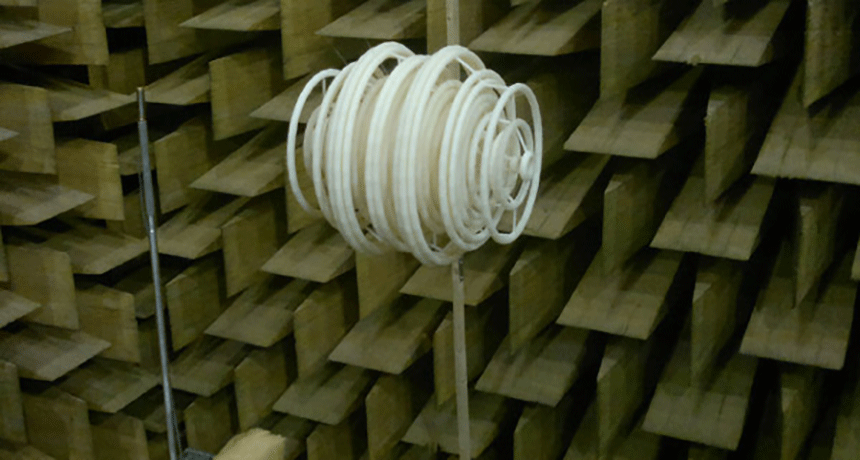Sound cloak
New device hides objects from sonar

This strange-looking cage can hide an object inside it from being detected by sound waves.
L. SANCHIS ET AL
It would be easy to mistake engineer José Sánchez-Dehesa’s latest creation for a trinket. The plastic gizmo is a mere 17 centimeters (6.7 inches) long and looks like a cross between a birdcage and an ostrich egg. But appearances can be deceiving. This little device achieves something never done before: It hides a solid object from sound waves. Essentially, it’s a cloaking device.
The device makes objects invisible to sonar. Sonar devices send out sound waves in search of objects in the dark or too far away to be seen. An object is detected when the sound waves bounce off of it and return to their source, like an echo. The new invention is the first acoustic, or sound, cloak that can hide a three-dimensional object. It was developed by Sánchez-Dehesa, of the Polytechnic University in Valencia, Spain.
It’s pretty basic: The only thing it hides right now is a sphere about the size of a Ping-Pong ball. But with some modifications, an improved version of the cloak could help cities reduce noise pollution.
Such a cloaking device might also help submarines cruise through enemy waters without being detected. Submarines use sonar to see who else is in the water. The new device could prevent sound waves that bounce off of a sub from returning to their source.
In the last 10 years, engineers have been figuring out new ways to hide things. Steven Cummer is an engineer at Duke University in Raleigh, N.C., who did not work on the new device. But he knows about cloaking. He helped develop the first invisibility cloak for light waves. Light, like sound, travels through space as a wave. And in 2007, Cummer first proposed the idea of a similar cloak to hide objects from sonar.
The new device applies “a simplified version of invisibility using well-designed but relatively simple materials,” Cummer told Science News.
A light wave scatters when it hits an object. That means the wave breaks, with each splintered signal traveling in a different direction. We can see things only when some of this scattered light makes it to our eyes. To build invisibility cloaks, engineers use complex materials that prevent scattered light from reaching our eyes.
In a similar way, Sánchez-Dehesa wanted to prevent sound waves from scattering. He also wanted to use simple materials. He used a computer program to design the cloak and a 3-D printer to print it. As printed, the device has 60 parallel rings of different sizes that encircle the object to be cloaked. Arriving sound waves scatter off the cloaking device itself and the cloaked sphere.
But Sánchez-Dehesa designed the cloak so that when the scattered waves from the cloaked sphere collide with the scattered waves from the cloaking device, they cancel each other out. Then, the scattered sonar signal can’t be detected — because the scattered waves have vanished.
It’s sort of like a tug-of-war: You can drag a rope if no one is pulling on the other end. But if someone else pulls with an equal force on the other end, the rope won’t go anywhere. The reason: The action on one side cancels out the action on the other.
Sánchez-Dehesa and his collaborators tested their device in a small, insulated chamber. They found that it didn’t work for most pitches of sound. Pitch refers to how high or low a sound is. But it did work for a particular high-pitched note. And it only worked when that sound arrived from one particular direction. Sound waves coming from other directions would not be canceled out.
It’s a start. And the U.S. Office of Naval Research — which partially paid for the study — will be looking for ways to use it to hide submarines. Cummer notes that even this first step can be useful. It might reduce the noise coming from one area, like a busy highway.
“The cloak does one thing quite well, with a very simple structure,” he said.
Power Words
acoustic Relating to sound or the sense of hearing.
sound wave A wave that transmits sound. Sound waves have alternating swaths of high and low pressure.
engineering The use of math and science to solve practical problems.
pitch The quality of a sound set by the rate of vibrations producing it; the degree of highness or lowness of a tone.







